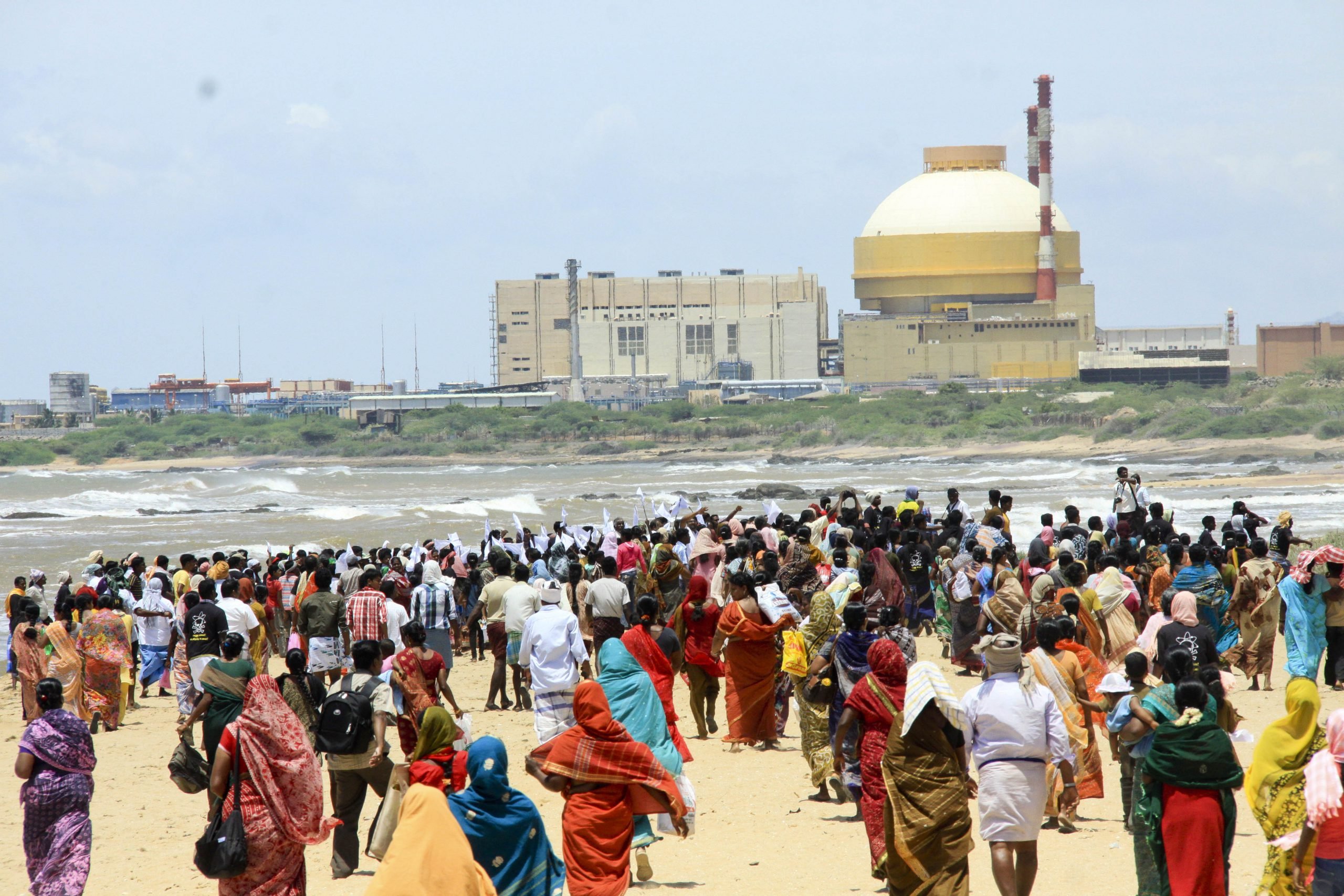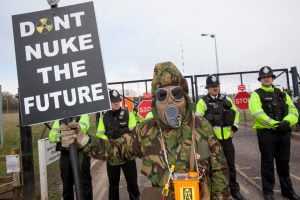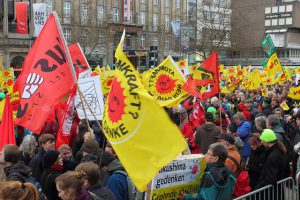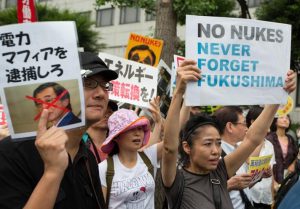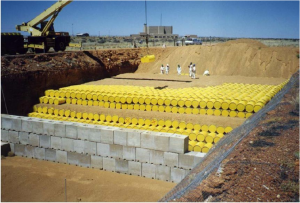When I jumped off the cycle rickshaw near the small coastal village of Haripur, in the Indian state of West Bengal in January 2010, I did not expect to stand in the middle of a dappled canopy of banana, mango and coconut trees, or see the great expanse of young crops of gourds, or smell the acrid cooking fires wafting from neatly thatched houses. I did not expect to hear the constant calling and rustling of birds, the lowing of cows, the whoosh of rice being sifted from stones or the gurgle of water jugs being filled. I was expecting a “barren wasteland,” as described by a senior Indian government official, where “most of the land [has] a high saline content and cannot be used for agriculture.”
I was searching for Anuradha Talwar, the woman coordinating the opposition to the West Bengal government’s attempted land grab to accommodate a 10,000-megawatt nuclear reactor complex in Haripur. Before it was eventually abandoned, this nuclear project was slated to be the largest on the sub-continent, with the potential to evict up to 200,000 farmers and fishermen from a six-kilometre radius.
I found Talwar sitting on a tiled veranda, directing a small army of young women tallying the results of a demographic survey of the villagers of Haripur. Talwar was determined to count every man, woman and child who might lose their homes and livelihoods to nuclear energy. She was not what I expected either. Instead of the lean, young, fiery activist I had imagined, she could have been someone’s kindly grandmother – middle-aged, with a plump face, oversized glasses and thinning grey hair.
Talwar, whose surname means “sword” in Bengali, leads the West Bengal Agricultural Workers Union, also known by its Bengali acronym PBKMS, and has spent decades fighting for human rights and sustainable development in sectors as diverse as healthcare, gender equality, labour practices, disaster relief, malnutrition and starvation. Her relationship with the Haripur nuclear scheme is longstanding too: in 2006, PBKMS mobilised 6,000 villagers to create a bamboo barricade to prevent scientists, engineers and police from entering the village to perform soil tests for the Nuclear Power Corporation of India. Their concerns centred on the potential human displacement and the lack of transparency over its consequences.
Also read: Why I continue to fight the nuclear plant next door
To Talwar and to the villagers in Haripur, nuclear power is nothing special – it is simply another manifestation of government policies contributing to a list of larger evils. Facing the spectre of the massive nuclear plant, they were not impressed by the prospects of developing a carbon-free energy system that would mitigate climate change, nor drawn into the debate over the risks and uncertainties of generating nuclear energy. For them, what mattered most was that the natural resources their livelihoods and culture depend on – land and access to coastal fishing grounds – were in jeopardy.
Civil disobedience across India
Around India, communities like Haripur are affected by the beginnings of nuclear power infrastructure. They, too, are taking surveys, handing out pamphlets, forming committees, voicing grievances to local papers, staging protests and stymieing government officials. Although the Haripur project has been abandoned with a change in political power, other villages are still mired in protests.
A dramatic case in point is the rising furore over the Koodankulam nuclear plant in the state of Tamil Nadu, at India’s southern tip, a project which began in 1989 and is now nearing completion. In the wake of Fukushima in 2011, the People’s Movement Against Nuclear Energy (PMANE) escalated its non-violent protest here after nuclear officials ran an emergency evacuation drill that called for villagers to “to cover their nose and mouth and run for their life”.
One of the main protesting villages is currently held under marshal law; the leader of PMANE and followers have been charged with sedition and war against the state; the police have arrested hundreds of villagers engaged in civil disobedience such as fasting, demonstrating and forming barricades; and the police have revoked ration cards for food and cooking oil. The Department of Atomic Energy even sent psychiatrists from the National Institute of Mental Health and Neurosciences in Bangalore to convince protesters that nuclear energy was safe.
Earlier this year, India’s prime minister Manmohan Singh invoked the trope of the foreign hand, stating that colonising, transnational NGOs had incited “scientifically innocent” villagers (a term used repeatedly by technocrats, according to one environmental-impact assessment expert) into misguided action, as reported in Science Magazine. In a symbolic act, protesters collected and surrendered 23,000 voter identification cards from nine villages to the district. Currently, the leaders of PMANE are being protected in one of the villages to evade arrest. But these acts have not deterred the protesters, who have emulated Gandhi’s practice of satyagraha (insistence on truth) and have taken to the sea, forming a human chain in the water around the nuclear power plant. It remains to be seen whether the ongoing protest will lead to a change in national nuclear energy policy.
Confronting historical legacies
These anti-nuclear protests, far from being isolated cases, are part of longer-term political trends, and very much shaped by historical events. In trying to build nuclear power plants in West Bengal, for instance, the state has been confronted by a number of legacies: the history of local Communist rule; a cultural memory of violent resistance to British colonialism; a movement against Special Economic Zones (SEZs) in response to neo-liberal economic policies in the 1990s; and a deep suspicion of the nuclear establishment.
The Communist Party of India-Marxist (CPI-M), a pro-peasant party that favours rural development over industrialisation, governed West Bengal from 1977 to 2011. But a political sea change in 2006 ushered in policies of economic liberalisation. Attempts to woo a Russian nuclear corporation were seen as a betrayal by the then-Communist government’s rural, agrarian voting base. In that tumultuous year, hundreds of people were killed in the villages of Nandigram and Singur, just kilometres from Haripur, as villagers tried to stave off government land grabs for industrial hubs – via the 1984 colonial Land Acquisitions Act – thus sparking the national anti-Special Economic Zone movement.
The fight against building the nuclear power plant in the neighboring village of Haripur was of the same piece. In Nandigram and Singur, community activism was spearheaded by Anuradha Talwar’s organisation, PBKMS. The group pursued an independent fact-finding mission to investigate police atrocities, violence committed by villagers and Communist party infighting.
While the anti-SEZ violence was not directly related to anti-nuclear protests, it nonetheless helps to illustrate how local political and social dynamics, rather than technological issues alone, have an important influence on whether and how the government’s nuclear energy ambitions will be implemented.
Nuclear fight: a struggle for Indian democracy
For Indian citizens, the heart of many of these protests is the acquisition and redistribution of land, and the right to participate in a highly technocratic, expert decision-making arena with non-technical knowledge. Nuclear energy is a crucible for a diverse suite of concerns: the risk and safety issues long promulgated by peace activists comingle with trenchant critiques of land grabs for nuclear power plants, and the destruction of livelihoods. Tribal desires to maintain sovereignty over ancestral lands containing uranium sources and preserve communal identity jostle with the lack of energy access in rural areas and the urgent need for economic development. Expert pronouncements on the safety of nuclear energy clash with growing numbers of citizens becoming proficient in scientific and legal matters pertaining to reactor design and due process.
And, with reports of police brutality, charges of sedition levelled against non-violent protesters, and a refusal by nuclear experts to acknowledge ethical and social concerns, the fight against nuclear energy is increasingly a struggle for Indian democracy.
The unrest over a programme intended to boost India’s broad economic fortunes and reduce the nation’s contribution to climate change is a cautionary tale of what can go wrong when policies are formulated primarily around technological considerations at the expense of profound concerns related to community well-being, culture and justice. Moreover, it illustrates the kinds of political and social challenges a nation faces as it tries to manoeuvre into a sustainable energy future, when most of its population still depend on natural resources like land and water for their livelihoods.
Monamie Bhadra is a PhD candidate in the Human and Social Dimensions of Science and Technology Program at Arizona State University and a junior fellow of the American Institute of Indian Studies. Her research focuses on the political and cultural dimensions of nuclear energy in India.
